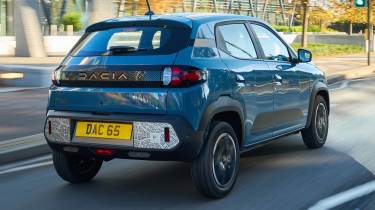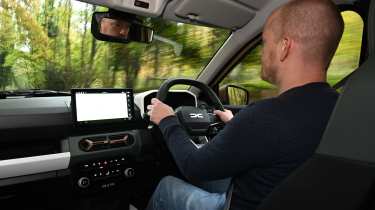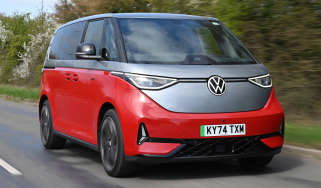New Dacia Spring 2024 review: an electric city car that ticks all the boxes
The all-electric Dacia Spring is cheap, efficient, fun and easy to drive

Verdict
Building a small car that turns a profit is very hard, and building a cheap electric powertrain isn’t child’s play either. So the fact that Dacia has brought a small electric car to market that’s one of the cheapest cars of any type that you can buy is a massive accomplishment. What it has created is pretty much the ideal city car: the Dacia Spring is tiny, nippy, fun and easy to drive, plus incredibly efficient and costs pennies to run. It feels cheap in places, but that’s because it is cheap. It deserves to be a huge success.
Fifteen grand won’t get you many new cars these days, and even fewer with electric motors. The fact that we’ve sung the praises of the Citroen e-C3 so highly that we named it our 2024 Car of the Year is down in no small part to the fact that, aside from being a great supermini, getting a full EV to market for less than £23,000 deserves huge praise.
So a fully electric car that starts from just under £15,000 is a very big deal indeed. Trust it to be value champions Dacia turning up with the goods, then. This is the all-new Spring: not only the cheapest electric car money can buy in the UK, but one of the cheapest cars full stop. Even the range-topping model costs a fiver under £17,000.
Although the Spring launched in Europe in 2021, there have been significant changes to the formula since that car launched. A new look, more tech and revised powertrains have all culminated in the car you see here today – progress enough for Dacia to decide it’s finally worthy of pitching to UK buyers.
It’s also given time for Dacia to analyse data from existing owners on how most Springs are used. On average, they drive 23 miles per day spread across four trips, taken at an average speed of 23mph. In both cases, it’s clear to see that these cars are being used for short commutes and local errands.
As such, the body has been prepped for city living. The chunky plastic cladding on the outside is dyed during the production process rather than painted later, which means that, should drivers pick up any battle scars on the bumpers, they won’t stand out too much. Those funky stickers on the front and rear bumpers don’t just add a bit of quirkiness, they also protect those bumpers more; scratch one, and you can just peel it off and buy another sticker. That’s much cheaper than having a bumper resprayed.
Simplicity can be seen everywhere, from the single windscreen wiper and washer jet, to the steel wheels (14 or 15 inches, depending on model). This is simple motoring without unnecessary fripperies or any pretence to be sporty or posh.
At 3.7 metres long, the Spring is roughly the same length as a Hyundai i10, and the tall, upright body translates into decent space inside. If the driver is nudging six feet tall, then kneeroom becomes tight in the back, but it shouldn't be too much of a hardship on short trips. The trade-off for the slightly tight back seats is a big boot. At 308 litres, that’s 56 litres more than you get from a Hyundai i10, and that number grows to 1,004 litres with the rear-seat bench folded flat. Add the £279 Storage Pack, and there’s also a little frunk beneath the bonnet to hold charging cables, plus a little storage bag for the boot and a front central armrest.
As you'd expect from the price, equipment levels aren’t exactly exhaustive, yet the top-spec Extreme comes with front and rear parking sensors, four electric windows, and a 10-inch touchscreen (lifted from the Duster) complete with satellite navigation, Android Auto and Apple CarPlay plus a reversing camera. The Base Expression model is more basic; that touchscreen disappears, but there’s still a seven-inch digital driver's display, air-conditioning, rear parking sensors and six airbags. If you’re the type to find the mandatory driver-assist systems like traffic-sign recognition and lane-keep assist a little irritating, then Dacia makes it easy to disable them; program which assists you don’t want in the MyPerso menu, and it can then be accessed quickly via a physical button on the dash.
The cabin itself looks basic but modern, with an upright driving position and good visibility all round. The steering wheel, which has been redesigned for the new Spring and is more in-keeping with the rugged design used by the new Duster, only adjusts for rake rather than reach, though that isn’t uncommon among city cars. Does it feel cheap? In some places, absolutely; the doors close with a tinny thunk and there’s lots of body-coloured paint on show inside.
However, there are plenty of practical touches too, with a total of 33 litres of storage spaces dotted around the cabin. The door bins are wide and deep up front, and their white plastic insides make it easy to find most items even when it's dark. Ergonomically, the Dacia is hard to fault, with physical knobs to adjust the temperature and fan speed and a small column stalk behind the steering wheel dedicated to the audio controls.
Much like the rest of the car, the stats for the electric powertrain seem tiny compared with what we’ve become used to. Power comes from a single motor driving the front wheels, with a modest 64bhp and 113Nm. And that’s the powerful choice; go for the entry-level car with that £14,995 price tag, and it’s 44bhp and 125Nm. At 26.8kWh, the battery is only just larger than the unit fitted to a Skoda Kodiaq - but that car has the back-up of a petrol engine and a fuel tank, too.
But the Spring doesn’t need a big battery - and not just because of the typical use cases we touched on before. It also has weight on its side, with the most highly specced models coming in at 984kg, a figure that’s less than half that of many of the big EVs and plug-in hybrids that are on our roads today.
That weight certainly plays its part for better and for worse, but the good news is that the benefits easily outnumber the drawbacks. It’s so refreshing to drive an EV that feels light on its feet; even though there’s not much outright power, the Spring lives up to its name with the way it responds to the throttle away from rest. Accelerating from 0-30mph, it feels sprightly enough, even though things tail off after that - hence the leisurely 13.7-second 0-62mph time. Given that the 44bhp model takes a whole 19.1 seconds to hit the same mark, we’d stretch to the more powerful option if you can. It’s offered in both trim levels, so if you don’t see any benefit in the Extreme's kit, then it’ll cost you £15,995 in Expression trim.
The tall, narrow body produces lean through the corners, so this isn’t a car to drive with too much verve - especially when the steering, though a recalibrated system compared with earlier Springs, still feels vague and short on feedback. The flip side is that the Spring boasts a tiny 9.6-metre turning circle. All we’d like to see is an improvement with the brake regen, because it can be tricky to be smooth under gentle braking, causing a bit of a nodding-dog sensation. Switching to ‘B’ mode improves this a little.
Comfort is reasonable. The suspension is just a little bouncy over poorer roads, with a Hyundai i10 delivering a smoother ride overall. The Dacia’s small, narrow tyres mean that road noise is much more hushed than in larger vehicles, despite a relative lack of soundproofing. It’s wind noise over 60mph that becomes most intrusive - but it’ll be fine for the very rare occasions when owners will bother to go over that speed.
The biggest benefit of the Spring’s light weight is efficiency. On a route covering a wide mix of roads, including a brief run at 70mph on dual carriageways (where it is at its least efficient), the Spring achieved 5.0 miles per kilowatt hour with ease. That translates to a real-world range of 134 miles - just six miles short of the official WLTP mark. Given that those results were achieved when the weather was cold - not ideal for an EV’s range - 140 miles-plus looks very achievable.
If you plan to make the most of that range on longer jaunts, then the Extreme comes with 30kW charging, which means a 20-80 per cent charge will take 45 minutes. However, Dacia says that 75 per cent of owners so far have charged at home, where a 7kW charger can fully charge the battery in four hours. The firm’s smartphone app allows owners to program charge times, so they can make the most of cheap overnight electricity, and the cabin can be pre-conditioned so that it’s nice and cool (or toasty) when you get in on a hot (or cold) day.
The Extreme trim even accepts vehicle-to-grid connectivity. Plug an adaptor into the Type 2 port on the nose and the Spring accepts a wide range of devices powered by a three-pin plug. Dacia says that you could even run high-powered appliances like an electric barbeque off the car, in which an hour’s use would consume roughly 13 per cent of the battery.
| Model: | Dacia Spring Extreme 65 |
| Price: | £16,995 |
| Price from: | £14,995 |
| Powertrain: | 1x e-motor, 26.8kWh battery (usable) |
| Power/torque: | 64bhp/113Nm |
| Transmission: | Single-speed auto, front-wheel drive |
| 0-62mph: | 13.7 seconds |
| Top speed: | 78 mph |
| Range: | 140 miles |
| Charging: | 30kW (20-80% in 45 minutes) |
| Size (L/W/H): | 3,701/1,583/1,519mm |
| On sale: | Now |












